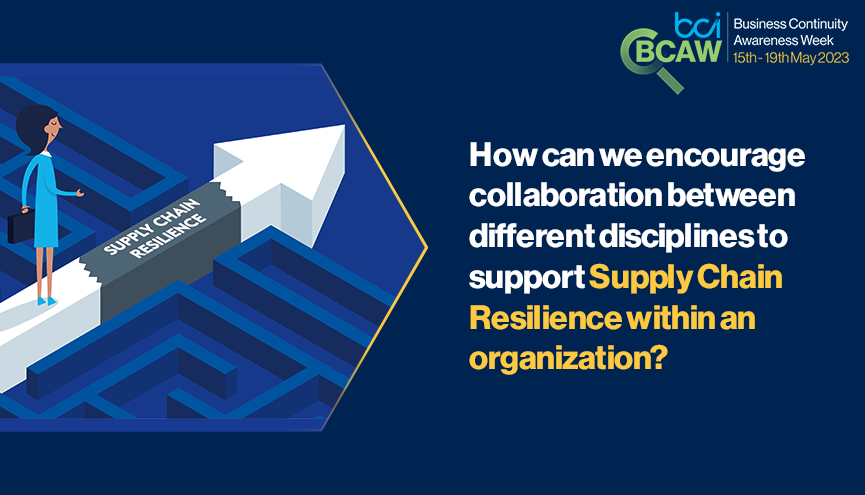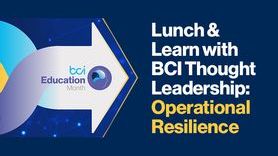How can we encourage collaboration between different disciplines to support supply chain resilience within an organization?

The BCI Supply Chain Resilience Report 2023 found that 11.5% of respondents had reported at least 10 disruptions within the past 12 months. Whilst this does seem to be trending lower than the peak number of disruptions in 2021, this figure is still more than double pre-pandemic levels (4.8%). Of course, this highlights the level of disruption to global supply chains that the pandemic has caused and how these effects are still being felt today.
Indeed, within the last 12-18 months, we have seen the impact of:
- COVID-19 lockdowns continuing across certain regions in China before the re-opening.
- Strikes in France, Germany, and the UK, for a wage rise or pension reform. The knock-on effects on these strikes causing disruptions at ports, airports, rail, road, public transport, etc.
- Ongoing military conflict in Ukraine.
Since these events have pushed the importance of supply chain resilience to the forefront of many an organization’s priority list, resilience professionals will be considering how to use this window of opportunity to increase supply chain resilience, keep it high on the agenda (making sure that engagement and support for this critical issue is maintained into the future), and reflecting on how we can use the learnings from these disruptions.
For example, one finding picked up in the Supply Chain Resilience Report is the need for a relationship between organizational functions, such as procurement and BC, when it comes to supply chain resilience. However, just one-third of respondents (36.1%) to the report have “business continuity feature as an integral part of the procurement process from the start, with an additional 32.8% who do so only where the contract risk is deemed high. On the flip side, 1 in 5 do not include business continuity considerations at all (21.0%).”
However, we can see the importance of collaboration between procurement and BC almost instantly during an incident. Zera Zheng, Global Head of Business Resilience Lead Logistics at A.P. Moller – Maersk, provides an example: “in case a supplier is impacted by labour shortage, such as strike or pandemics, by timely informing the manufacturer, the manufacturer can react early by sourcing alternatively and therefore mitigate the impact to production. And the distributor and retailers can plan ahead and avoid loss of sales.”
In this example, the reaction of the organization (a manufacturer in this case), is key to keeping disruption to a minimum – a key objective of business continuity. Although, this reaction involves finding alternative sources/suppliers – perhaps a responsibility of procurement. Therefore, it is clear how collaboration between internal departments within organizations is vital to supply chain resilience. We will be exploring this in further detail throughout this article.
The benefits of working collaboratively
“Collaboration is key to building up supply chain resilience,” says Zera Zheng, Global Head of Business Resilience, Lead Logistics, at Maersk Ocean & Logistics. Considering this issue from an external perspective, she says that a supply chain involves multiple nodes, such as suppliers, manufacturers, distributors, and retailers, all of whom must work together to ensure that goods and services are delivered efficiently and effectively. Therefore, this chain can become more effective if there are strong working relationships and visibility down the supply chain.
This works extremely well as an example of resilience within the wider supply chain, but in order to develop these strategies, organizations will likely need to build an awareness of the importance of supply chain resilience within their own operations first. One form of this is understanding the mechanics of different organizational departments and their relationships with external suppliers. Once we have built an awareness of our own organizations, we can leverage the existing business relationships in our capacity as a BC or resilience professional.
“If your technology team have the relationship with a cloud provider that supports your most important business service then, as a resilience professional, you should aim to attend their meetings with the supplier on a regular basis and discuss any incidents that have impacted your company, or discuss their resilience strategies and look at ways you can work closely with them during exercises or post-incident reviews,” says Rob Cooke MBCI.
Of course, another benefit of this is that, when incidents occur, “you have a greater chance of a faster recovery as you will know who to work with and how the supplier responds to incidents,” adds Rob. However, before we get to this stage, we can build resilience into the supply chain by ensuring that it is discussed and valued at even earlier point in the process.
Collaboration between procurement and BC internally
Since, as we’ve seen in the introduction, 21% of respondents say that their procurement process currently doesn’t include BC at all, in this article we will be focusing on collaboration opportunities between these two disciplines and the benefits of such a relationship.
For example, in the event of the loss of a supplier, procurement may take on the role of managing the lost supply line as an interface with suppliers. David Window MBCI notes that this might be called a “Task Team”. “Having been a procurement task team leader in an incident, the role, often at Tactical Response level, is to recover priority supply lines, services, and resources. They have the in-depth knowledge of the market and are empowered to create contracts under emergency powers within an organization.” Therefore, if the aim of the BC team in this scenario is to maintain operations at an pre-defined, acceptable level, then the necessity of close collaboration between these two teams is clear.
“If the 3 disciplines of risk, procurement and BC do not collaborate, a word used frequently in the Good Practice Guidelines (GPG), how can anyone expect to gain resilience within an organization, which probably has a great dependency on either outsourced services or bought in goods and services,” adds David.
Of course, a first step in this process is for BC and resilience professionals to ensure that they are engaging with the procurement functions in their own organization before an incident.
“BC professionals may not speak the language of procurement professionals, and this disconnect often creates a barrier,” says David. He adds that some in BC may suggest processes for a supplier performance appraisal that a procurement professional would never consider, “so we need to offer a more realistic view to better engage with those who manage procurement.”
Looking wider, there is also a risk that this lack of a shared language could manifest itself in industry standards, as David explains. He notes that ISO TS 22318 (Security and resilience — Business Continuity management systems — Guidelines for supply chain management) recently went through a review. To increase the sense of a shared language and mission during reviews such as this, he explains that it would be useful to have a greater diversity and balance on standards groups, with both BC professionals and procurement represented.
Focusing back on an organizational level, we know that one way to embed shared values, such as keeping an organization resilient through collaboration, is through regular shared training. This is an easy way to start a discussion between different parts of the organization and understand each other’s roles in building a resilient supply chain, for example. As noted above, this does not need to be just between procurement and BC professionals but could involve all disciplines who have a shared goal.
“My dream class (still trying to make it happen) is a class with risk managers, procurement managers and BC managers,” says David.
Collaborating with external suppliers
As we are looking at supply chain resilience, it is also critical to consider how collaboration between BC and procurement personnel could benefit the wider supply chain when onboarding a new supplier. Only 36.1% of respondents to the Supply Chain Resilience Report said that business continuity features as an integral part of the procurement process from the start.
Having BC as part of the procurement process means that external suppliers can be onboarded with both parties understanding the BC requirements of either organization. Indeed, all parties would surely prefer to have a conversation about BC credentials at this stage in the process, rather than waiting for an incident only to discover that your new supplier doesn’t have a plan for this situation and will now fail to deliver.
However, it is also important that we utilise the relationships and potential collaborations within our organization so the information we have about our external suppliers can be put to use.
“Risk, within the supply chain, is usually understood best by procurement professionals called “category managers”. BC managers understand BC requirements for the organization. We ask the “end user” in operations to nominate “priority suppliers” then we do very little with that information, as the [Supply Chain Resilience Report] survey suggests,” explains David.
A potential benefit of this collaboration between internal procurement and BC functions may even include a competitive advantage during the tendering process. The Supply Chain Resilience report shows that, for those working in the procurement process, 1 in 5 respondents had to provide assurance to the majority of their clients that their organization’s BC arrangements were sufficient during the tendering process. As awareness of the importance of resilient supply chains continues to grow, it will become even more critical for BC/resilience practitioners to have a functional relationship with those in procurement, so both parties can provide assurances of their own credentials and share details of any upcoming exercises when needed.
“You should ensure you have a strong relationship with your procurement team along with the suppliers who maintain your important business services and the departments that manage those relationships. Look at ways to work closely with suppliers and potentially involve them in exercises to ensure that plans work well and they can support faster,” says Rob Cooke.
While including external suppliers in exercises is a good long-term solution to improve supply chain resilience, David outlines some further measures which could be taken during the tendering process:
“What we need is to build BC requirements into performance specifications in tenders and requests for quotes, and analyse bids for a supplier solution to achieving those performance stipulations through a service level agreement and contractual promise.”
This is in itself a demonstration of a positive outcome which comes from collaboration between those in BC and procurement. Again, without this collaboration in this tendering process, there is an added risk of suppliers overpromising when bidding, since those responsible for the contractual arrangements may not understand BC. Then, “when disruptive incidents occur, all parties wave contracts at each other, which does not give you service continuity,” adds David.
Maintaining this awareness going forward
Once we have these relationships between our internal teams, and now our external suppliers, in place, organizations need to maintain their levels of resilience at a high standard.
Zera Zheng provides several methods of ensuring that our work on building these relationships continues. She concludes by advising that maintaining awareness of BC and supply chain resilience can be achieved by:
- Engaging personnel in the contingency planning and risk assessment
- Providing personnel with the trainings
- Exercising and testing the continuity plans with them
- Keeping them informed of disruptions
- Involving personnel in the handling of disruption
Authors:
- Rob Cooke MBCI, Head of Operational Resilience, Griffin
- David Window MBCI, Director, Continuity Shop
- Zera Zheng, Global Head of Business Resilience, Lead Logistics, at Maersk
- Kieran Matthews, Content Manager, The BCI
Get involved in BCAW 2023 - follow the link below:









































